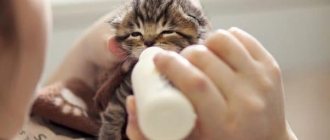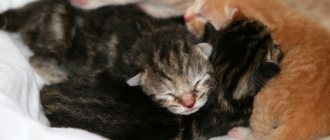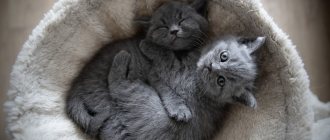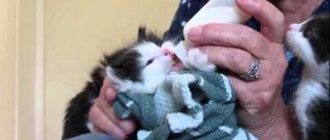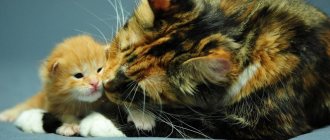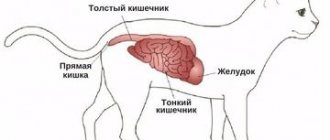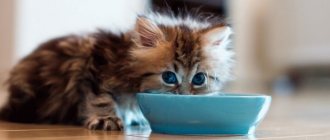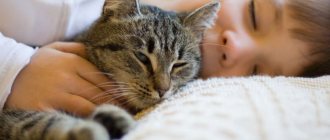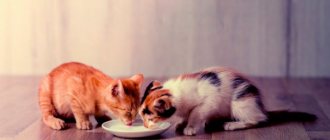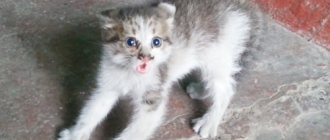How much to feed newborn kittens
The stomach of newborn kittens is about the size of a cherry. A small amount of food (4-5 ml) is placed in it. This amount of food is digested quite quickly, so newborn kittens need to be fed frequently: every 2-3 hours day and night.
Until day 4, you need to feed the baby every 2 hours. Starting from day 5, we increase the break and start feeding after 3 hours. After 2 weeks, we reduce it to one feeding at night, but during the day we also feed every 3 hours. From about day 25 we increase the break again and now it is 4 hours, but at night one feeding is also necessary.
Now let’s figure out how much milk newborn kittens left without a cat need. From birth to the 7th day of life, the amount of food for a kitten is 4-5 ml per feeding and 25-33 ml per day. The number of feedings is approximately 7 times.
For two-week-old cubs, 9 ml of food is required once and 45-55 ml per day. You need to feed 6 times.
At 3 weeks we give 15 ml of food at a time, and 75-85 ml per day. Number of meals 5 times.
When a kitten is one month old, it needs 20 ml per meal and 105-115 ml per day. We focus on 5 meals a day.
Feeding Basics for Newborn Kittens
The baby's body is very sensitive. It is important to follow the rules on how to feed newborn kittens without a cat, because the slightest deviation can cause digestive upset.
- Hygiene. Before feeding, wash your hands thoroughly with soap. Feeding dishes must be sterilized by boiling for 15-20 minutes.
- Temperature. Food is fed to the kitten at a certain temperature of 36-38ºC. It is best to heat in a water bath and it is highly not recommended to use a microwave oven.
- Freshness. It is better to prepare the milk mass before feeding.
- Mode. Feeding the cub must be carried out according to a schedule, day and night, otherwise the kitten may die. The norm must be followed. Overeating and undereating have negative consequences. If the kitten is full, it will fall asleep or simply stop sucking.
- Pose. Feeding should be done in the correct position so that the baby does not choke and the food is better absorbed. The correct position is lying on your stomach.
- Procedures after feeding. When the baby has eaten, give him a vertical position and hold him like that for a while. This will promote regurgitation. Next, it will be useful to massage the tummy to stimulate the act of bowel movement.
How to feed a newborn kitten
Newborn kittens cannot eat on their own, so they have to be force-fed. How to feed newborn kittens without a cat? For these purposes, use a pipette or a small feeding bottle. Sometimes it works well to administer food using a medical syringe.
How to feed newborn kittens: for convenience, it is better to place the little orphan on your lap or create a cozy bed with sides made of warm and soft fabric. The baby's position should be as natural as possible; the best option is lying on his stomach. During feeding itself, you can slightly raise the front part of the body so that the kitten is at an angle of 45 degrees. Next, we bring a bottle with a nipple and our cub, sensing the smell of food, will attach itself to the bottle and the sucking reflex will work. Do not press on the bottle or pipette; in this case, the kitten may choke.
Try to feed so that the baby sucks and does not swallow air, otherwise the excess amount of gas in the stomach will bother the pet.
When the baby is full, he will fall asleep or simply stop sucking.
After you finish feeding, massage your tummy - this will stimulate intestinal motility.
Diet of newborn kittens
The best food for small cubs is, of course, mother's milk. What to feed newborn kittens if the cat has no milk or the baby is an orphan? If you yourself have to solve the problem of how to feed the baby, then there are several options for how to deal with this situation. The best solution would be to find a nursing cat who can provide the kitten with milk. If this is not possible, then whole cat milk can be replaced with a special mixture for newborn kittens. You can prepare it yourself or buy it ready-made at a pet store.
At the age of 2 weeks, you can start adding porridge with milk to your kitten’s diet. And after 3 weeks, you can include complementary foods from protein products, such as:
- Baby meat puree. Be sure to read the ingredients so that there are no spices or salt.
- Cottage cheese with a minimum percentage of fat content.
- Beef, well cooked and finely ground.
- Boiled sea fish without bones, chopped.
- Egg yolk.
When the kitten is one month old, you can start teaching him to eat from the bowl himself.
Is it possible to feed a kitten with baby food?
Many cat owners sooner or later give birth to offspring, but, like some women, cats that give birth sometimes do not have or do not have enough milk to feed the newly born babies. But a natural question arises: is it possible to feed a kitten baby food? According to the laws of nature and veterinary requirements, a kitten must be fed only milk for up to four weeks. Where can a person get milk to feed a little blind kitten? The first thing that comes to the owner’s mind: powdered infant formula.
Feeding
The newborn period in kittens is called the suckling period. Babies are born undeveloped and blind; mother's milk helps them grow stronger and open their eyes. Veterinarians do not advise switching to infant formula designed for children. There are formulas that replace cat milk. The mixture is stored for a long time, it is the best option for feeding the baby. If there is an abundance of baby formula in the house, that can also be used. They just dilute it in a one to one ratio. Milk formulas designed for children are fattier and richer in microelements, which in excess will be harmful to a newly born kitten.
Features of formula feeding
To raise a fully developed newborn kitten, you must follow several rules:
- feed three, four times a day; the intervals between meals are chosen by observing the baby; the kitten will be on artificial nutrition for one and a half months; For feeding, use a bottle with a small nipple; a bottle filled with the mixture is heated to the kitten’s body temperature; It is necessary to wrap the baby in a warm towel.
Newborns are unable to independently regulate their body temperature. His self-regulation will begin at ten days of age.
Other reasons
If a kitten is allergic to baby food for kittens, which is designed specifically for him, then you can use baby food. There is only one condition: it is necessary to examine the baby to see if he has itching or flaky skin.
If your baby is given prepared baby formula as food, you need to keep an eye on him. If the kitten fell asleep peacefully, woke up cheerful, his stool is normal and nothing bothers him, he feels good, then the food is suitable . You can safely give this mixture more than once a day.
Other rules for feeding kittens
Kittens have just been born, it is difficult for their digestive system to adapt to the harsh conditions of their new life. A month or two will pass, and the two-month-old baby will learn to regulate his body temperature and get used to the food that his owner offered him. If you give your kitten baby food, you should wait to accustom it to raw foods from childhood.
Natural instinct
The kitten is a future predator and needs to hunt on its own. Sooner or later he will catch the mouse and eat it. There is nothing wrong with this, nature requires it. In order for a kitten to grow into a full-fledged healthy cat, you need to take care of its proper baby food. You should listen to nature and veterinarians, who recommend including the following products in the diet of kittens, cats and cats if they are fed on infant formula :
- liver, beef meat (not duck, goose, or pork), carrots, cabbage, buckwheat and oatmeal, rice, cottage cheese, kefir, yogurt (rarely give milk), raw water.
Whatever nutrition option the owner chooses, it is necessary to monitor the condition of his pet. It is not recommended to constantly add baby formula to your diet.
The unexpected discovery of a newborn kitten on the street or a mother cat abandoning her offspring is a reason for panic not only for beginners, but also for experienced animal owners. How to take care of the baby, how to protect it? There are a lot of opinions and advice on this matter, but the main stumbling block is proper feeding. Let's figure out whether it is possible to feed a kitten with baby food and what can be done to keep the baby healthy.
What you need to feed kittens
Essential items include the equipment you will use to feed your kittens. You also need to purchase what you will feed. You may need a ready-made mixture or products for its preparation.
Feeding set
Feeding newborn kittens is a difficult and very responsible process. The following devices will help in this matter:
- 20 ml syringe
- Pipette or pacifier
- Feeding bottle
- Measuring spoon
- A bowl
Feed options
What to feed newborn kittens or what to replace whole cat milk with? The best option would be a nutritional mixture, which you can purchase ready-made in the form of a dry powder or prepare the milk mass yourself.
Ready-made formulas for newborn kittens are sold at a veterinary pharmacy or pet store. The kit already includes a feeding bottle, a set of nipples and a spoon for measuring the powder. Their cost is quite high. To save a little money, you can use baby food.
Many owners prepare nutritious milk formula themselves. There are quite a lot of homemade recipes. The main ingredients are eggs and milk.
Feeding with homemade formula
Until two weeks of age, a kitten should be fed only with a nutritional mixture made from natural products. Next, complementary foods are introduced: porridge, meat baby food, low-fat cottage cheese.
Blend recipes
Let us note right away that whole cow’s or goat’s milk is not suitable for feeding. They are prepared in a special way.
Recipes, based on the number of ingredients, can be divided into simple and complex. Simple compositions may include 2-3 ingredients, and complex ones 4-6 ingredients.
Recipe No. 1 Thoroughly mix 500 ml of milk, one chicken yolk and 4 tsp. Sahara.
Recipe No. 2 Take 1/4 cup cow's milk, 1 tsp. milk powder, 1 gram of vitamin supplement and a few drops of glucose. Mix all ingredients thoroughly. Before feeding, heat in a water bath to 37ºС.
Recipe No. 3 Condensed milk 800 ml (no sugar), warm boiled water 200 ml, meat and bone meal 5 mg. Mix thoroughly and warm to room temperature.
Recipe No. 4 Take 100 ml of milk, one egg yolk, 20 ml of 5% glucose solution. Mix all ingredients, heat in a water bath to 36-38ºС. Before feeding, add 0.1-0.3 ml of Vittri.
Recipe No. 5 Mix the following ingredients thoroughly: 15 g of milk powder, 5 ml of cow's milk, 2.5 g of dry yeast, 4 g of sugar and 1 ml of vegetable oil. Separately beat until foamy and add one chicken egg.
Important points when preparing
If you prepare a nutritional mixture at home yourself, then remember a few banal but very important rules:
- If you prepare the mixture yourself, then pay attention to the expiration dates of the products used. Store them correctly, as written in the instructions. Products such as milk and eggs are stored in the refrigerator. If you add glucose or liquid vitamins, store them in a place protected from light.
- All ingredients must be thoroughly mixed. They should not form lumps or separate. To achieve the most uniform consistency, use a whisk.
- When cooking, follow the recommendations indicated in the recipe. Observe the proportions strictly.
- It is best to prepare the mixture immediately before feeding. If this is not possible, then you need to remember the shelf life of the finished mass: no more than 24 hours in the refrigerator.
- The food must be fed to the kitten warm. It should be at the baby's body temperature. To make sure the mixture is correct, apply a drop onto your wrist. If you feel neither cold nor hot, then the temperature is right.
- Heat food only in a water bath. A microwave oven or stove is not suitable for this purpose.
Kitten formula recipes
1. In a liter of boiling milk, stir 1 teaspoon of bone meal, 200 milliliters of condensed milk without sugar and 100 milliliters of water. The resulting mixture is filtered and cooled.
2. Mix 2 egg yolks, a glass of milk, 1 teaspoon of vegetable oil, 1 drop of Tertravit or Trivit vitamins.
3. Use 0.5 teaspoon of unrefined vegetable oil as an additive, “Tertravit” up to 0.3 milliliters, “Vitom” - on the edge of a knife. Without additives, the mixture can stand in a cold place for 24 hours. When additional components are added to half the solution before feeding, the mixture is filtered through a sieve and heated in a sterile container immersed in warm water.
4. Goat or cow's milk is mixed with protein in a ratio of 4 to 1 and whipped until smooth.
5. Mix 50 ml of raw and 50 ml of boiled milk, 0.5 yolk and 1 tsp. corn oil.
6.1 egg yolk, 0.5 l. concentrated milk is mixed until smooth.
7. 200 ml of cream with 10% fat content is diluted with water 1:2. A glass of 10% cream should be diluted with boiled water in a 1:2 consistency.
8. For weak babies, the mixture is prepared from half a glass of milk with a fat content of 3.2%, 20 ml of glucose (5%) and 1 yolk.
Ready-made formulas for feeding
To feed newborn kittens using commercial formulas, just follow the package insert. The composition of this nutritional cocktail is as close as possible to the composition of whole cat milk. Feeding kittens using ready-made formulas is the best option. You can buy them at pet stores or veterinary pharmacies. They come in powder form, which must be diluted in the required proportion. The set consists of 3 bags of powder, 100 g each, a measuring spoon, a bottle with a scale and a nipple attachment.
Royal Canin Babycat milk
Price 1186-1385 rubles weight 300 g.
You can feed newborn kittens up to two months of age.
The composition contains: milk protein, fats, oils, vitamins, minerals and aromatic additives.
One scoop of powder is diluted in 20 ml of water. To do this, pour hot water at 50ºC into a bottle, add powder, mix well until smooth. Wait until it cools down until it is suitable for feeding.
BEAPHAR Kitty Milk
Price 683-960 rubles weight 200 g.
Designed for feeding kittens up to 8 weeks.
Ingredients: cow's milk and dairy products, fats, oils, vitamins and minerals.
The powder is diluted at the rate of 1 spoon per 20 ml of water. The water should be 50-60ºС. Stir until the powder is completely dissolved. Cool to 38ºС.
Hartz
Cat milk replacer made in the USA. Suitable for feeding newborn kittens up to a month.
The composition contains the necessary substances that promote normal growth and development of the pet. The taurine content is important; it is necessary to maintain vision.
The powder is mixed with liquid in a ratio of 1:2. You can use room water. Be sure to mix well so that all lumps dissolve.
Katzenmilch
Powdered milk with low milk sugar (lactose) content. Contains amino acids and concentrated grape sugar.
A reduced amount of lactose helps prevent vomiting and diarrhea.
Dilution is carried out 1:4, namely 1 part powder and 4 parts warm boiled water. Stir well until smooth.
Kittenmilch CDVet
Price: 1145-1300 rubles, weight 200 g and 4419-4700 rubles, weight 750 g.
A cat milk replacer that contains not only whole milk, but also colostrum. It is known that colostrum is an important product and helps strengthen the immune system in newborn kittens. Does not contain synthetic additives, which is definitely a plus. The Kittenmilch CdVet substitute is perhaps one of the most expensive.
One part of the powder is diluted with three parts of hot water. Mix well, cool to 30-40ºС.
Gimpet Cat Milk
Cat milk replacer comes from Germany. It has a composition rich in vitamins and minerals. Manufacturers also haven’t forgotten about taurine, which is good for vision, and arachidonic acid, which ensures healthy skin and coat.
Mix the powder with water at 50-60ºС in a ratio of 1:3 (1 part milk powder to 3 parts liquid). Cool to room temperature before feeding.
Baby formula
Store-bought formulas for newborn kittens are very convenient to use, but have a high cost. To save a little money, you can use baby food. This food is also good for kittens.
It is worth choosing proven brands, such as: NAN, Nutrilon, Similac, Nestle Nestogen, Friso, Agusha, Nanny, Humana. Focus on baby food up to 1 month old. Baby food must be diluted 2 times weaker than indicated in the instructions.
When should you not feed your cat baby food?
The first thing you should pay attention to is the animal’s reaction to a change in diet. If your pet resists eating baby food with all his might, he should not be forced. You should also not take risks if your pet has a hypersensitive digestive system. In such cases, the risk of an allergic reaction to food components is too great.
It was already mentioned above that under no circumstances should you give your cat baby food containing onions and garlic. The thing is that these two vegetables contain a disulfide component, which affects the destruction of red blood cells in the cat’s body. The constant presence of disulfide in the blood leads to the formation of hemolytic anemia and can be fatal. If baby food contains sugar or salt in large quantities, it should also not be given to your pet. Otherwise, this will result in serious disruptions in the functioning of the digestive system.
Another common mistake is using exclusively meat baby food for your cat’s diet. In the wild, cats also eat a variety of grass and vegetables. Without the presence of plant foods in the diet, the pet’s body will not function normally. That is why you can safely add pieces of carrots or tomatoes to the meat puree.
Typically, caring owners use baby food in cases where it is necessary to transfer the animal from old food to new food. In such cases, special mixtures designed for babies will help add the necessary variety to the diet, accustoming the pet to a new feeding algorithm.
Veterinarians advise using baby food of the Agusha and Tema brands. It is believed that such food contains exclusively natural ingredients, and there is no room for salt, sugar and various preservatives in their composition.
Proper nutrition for a pet is a real science that requires patience from the cat owner. You can use baby food as the basis for your diet, but you should also take into account the individual needs of your pet.
What to do: feeding tips
How to feed a newborn kitten without harming it? This matter is quite complicated, especially if you do not have experience in this important matter. Here are tips to help you navigate the complexities of this process.
- You feed the kitten according to the prescribed norms, it turns out that he ate the intended portion, but continues to make sucking movements. The first thought is that the kitten hasn’t eaten enough, you need to give it more. In this situation, there is no need to rush. Take him in your arms and look at his belly. If it is rounded and quite dense, this is a sign that the pet has eaten to its fullest. In this case, the baby uses sucking as a means of calming. He gets the impression that the mother cat is nearby.
- Overeating is undesirable and this point needs to be monitored by stool: if the kitten has eaten a little more than normal, then its stool will be yellow. When the stool is green, this indicates that the baby is overeating more significantly. Gray stool is a sign that the baby is constantly receiving excess food.
- You may also encounter the opposite situation when the kitten does not eat the intended portion. The reason for this may be a painful condition. If you notice that, in addition to poor appetite, the kitten is lethargic and is not gaining weight well, then something is clearly wrong with it and you should contact a specialist. But if your four-legged friend is active, has stable weight gain, and his feces and urine are normal, then there is no reason to worry. This means that the pet requires less than the norm.
- When you present a pacifier or pipette to a kitten, and he refuses to suck, squeeze out a little food so that he smells it. If this does not help, then stimulate the sucking movements by lightly stroking the baby’s back and forehead.
- It is recommended to give a single dose of food in two doses with a break of approximately 15-20 minutes. This is due to the fact that a hungry kitten pounces on food and does not realize when it is full. The break will allow him to calm down a little and eat the second half of the portion with less greed.
- Night feeding must be mandatory, otherwise the digestion process is disrupted. Hungry kittens become restless, make searching movements, and squeak.
- The nutritional mass is prepared immediately before feeding. The amount of food should be for one serving. Due to the fact that the digestive system is not yet developed, eating food that has been sitting for some time can lead to increased gas formation and discomfort in the stomach and intestines.
- When feeding, it is necessary to control the position of the kitten's head. If you throw your head back too much, then in this position the airways are compressed and the baby does not have enough air while sucking. He may choke and even suffocate.
- It is better to buy milk for preparing the mixture at home at the market. This product does not contain preservatives, food additives or other negative components.
It is very important to provide the kitten with adequate nutrition in the first months. This will help build immunity, start digestion, and ensure the eruption of baby teeth.
About feeding kittens
Let us immediately determine that a blind kitten on the street, even if it is in a box and covered with a cloth, is a non-resident. If you find such a find, the decision is yours! Feeding kittens is a big responsibility and literally sleepless nights.
The only chance to save a newborn kitten that is not fed by a cat is a person. Even if you decide that you cannot help your baby, there are some things you can do:
- Try to find someone who can pay attention to feeding, taking the kitten for a while. Going to a clinic where the kitten will be euthanized - you may think that this is cruel, but is a slow, starving death more humane?
The next important point is the chances of survival. If you take on feeding babies that have been rejected by a cat, that is, they were warm, were not injured, etc., the chances of survival are higher. If you find a blind kitten on the street, you should be prepared for the fact that it may die due to:
- Hypothermia. Too much hunger. Received injuries.
Note! Cats are very good mothers and they rarely abandon their offspring, but if this happens, the babies need to be shown to a doctor.
The fact is that a cat can leave offspring if they are not viable, for example, premature. In this case, if you decide to feed orphan kittens, all the risks and scenarios will be known to you in advance.
The chances are very low for kittens that have not developed a sucking reflex or the digestive process has stopped . A stop can happen for two reasons:
- The kitten has been starving for too long. The kitten has never suckled milk; in fact, in this case, digestion has not yet started and the chances of survival are higher.
The absence of an oral reflex is almost always tantamount to doom. A kitten may refuse to suckle if the reflex is not yet developed (prematurity) or if it is too weak (precomatose or lethargic).
Tip: In the early stages of lethargy, a kitten can be brought back to consciousness by warming it up and vigorously (but gently) rubbing the body from the limbs to the heart.
So, you have a newborn kitten, what should you do first? Decide what and how to feed. We will talk about choosing the type of feeding below; there are several answers to the question of what to feed:
- A syringe without a needle is not the most convenient method, but it will work as a temporary solution. A pipette is also not the most convenient method, since the kitten knows how to suck, not lick. A syringe with a rubber nozzle - a rubber band from a pipette, a piece of tube from a dropper or a rubber catheter is put on the hard nose of the syringe. The kitten will be able to suck the rubber nozzle, and with the help of the piston you will be able to conveniently control the flow of milk. Just one caveat - make sure that the kitten does not suck in the nozzle; it must hold securely. Container for drops for the nose, ears, etc. - the tube must be thoroughly rinsed, doused with boiling water and make sure that there are no foreign odors left in it. A special bottle for feeding kittens - like a baby bottle, with a nipple, only much smaller.
Important! The kitten must suck, that is, make an effort to get milk. If you simply pour the mixture into your baby's mouth, he may lose his sucking reflex.
